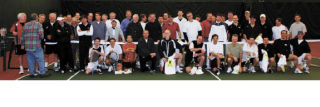Pumping a keg and ordering pizza are not two activities normally associated with tennis. But when a men’s tennis league, consisting of over 150 members, convenes for its annual league championship tournament, all bets are off, or maybe on.
“Well, we have enough doctors here that if someone has a heart attack, we’re covered,” said Mercer Island Country Club General Manager Kelly Evernden, an event organizer.
“But we have enough lawyers here to tell us who can use the defibrillator,” added Eric Andersen, a long-time participant.
The league, held at the Mercer Island Country Club, crowned its 2008-2009 champions on Thursday evening. Rob Crandall and Mike Seifert took first place among the doubles teams and their squad, The Breakers, won the overall title.
“From the wives’ standpoint, they know where [their husbands] are,” said Evernden. “But this is the largest men’s member-participated tennis league in the Seattle area.”
The league was not always this big, starting when the indoor tennis facility was built in 1984 with about 20 players. Back then, the tournament was a singles, not doubles, competition.
“Back in the old days, Tuesday was men’s night,” said Andersen. “It has just gotten bigger and bigger.”
The increasing number of participants led to a doubles play tournament. The season runs from September to early February with a draft to select teams. The draft was incorporated to make sure that the participating teams are new each year and balance out skill levels based on the United States Tennis Association’s rating system.
“Some teams have the same buddies each year and they don’t care if they win,” said Evernden. “That is OK. But we adjust the rules each year to prevent some guys from taking advantage of loop holes.”
The draft order is based on the previous year’s ranking and is set up to challenge players to meet new people and prevent dynasties. Drafted teams are comprised of 10 players with one captain. The captain then pairs up the five doubles teams from within the drafted team. Where each doubles team finishes within the tournament is given a numerical value and the total points scored by the 10-man team determines the overall championship.
“We have a pretty good sprinkling of skill levels between players,” said Tom Garrison, 67, a former participant and Club general manager, and he is main tournament organizer.
The age range of the players involved is as vast as the skill levels, with the youngest being in his early 20s and the oldest near 70.
“I’ve never seen anyone get overheated over a call,” said Tom Waldron, a four-year member. “It is good competition but casual.”
The prospect of playing a big match on Thursday evenings gives some players the motivation to practice throughout the week, leading to a big benefit for busy professionals. The competition does not get in the way of friendships, networking or even the occasional ribbing.
“The conversations lately have been about the economy and whether people are still employed,” said Waldron. “But this is a great way to meet other members and the genius is having it on Thursday night cause it is a dead night.”
Some members have met their future bosses through the league, some have gained some longtime friendships, while others have improved their backhand.
The building of the indoor facility allowed the league to flourish, with organizers not having to worry about USTA matches, vacations and other distractions that can come with the weather in spring or summer.
“It is a great thing cause you can come in and have 100 friends immediately,” said Evernden.
The popularity of league was most evident on registration day. The roster was full within two hours.
And while some players were watching the Huskies lose to the University of California on a big screen TV instead of the action on the court, and most were immersed in conversations with friends, all knew that this was where they wanted to be each Thursday night for the past five months.



